

"Be Worry, Don't Happy": Minor key. Musicianship - How to Identify Major and Minor Chords by Ear. Tonalité. Un article de Wikipédia, l'encyclopédie libre.
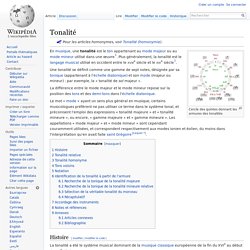
Cercle des quintes donnant les armures des tonalités Histoire[modifier | modifier le code] La tonalité a été le système musical dominant de la musique classique européenne de la fin du XVIe au début du XXe siècle. Le terme tonalité a été créé par Alexandre-Étienne Choron en 1810 puis emprunté par François-Joseph Fétis en 1840. Selon Carl Dahlhaus ce terme aurait plutôt été inventé par Castil-Blaze en 1821. Fétis précise le concept en 1844 comme « la collection des rapports nécessaires, successifs ou simultanés, des sons de la gamme[2] ». Minor scale. In music theory, minor scale may refer to: a heptatonic scale whose first, third, and fifth scale degrees form a minor triad,[citation needed] that is, a 7-note scale in which the third note is a minor third (three semitones) above the first, and the fifth note is a perfect fifth (seven semitones) above the first.
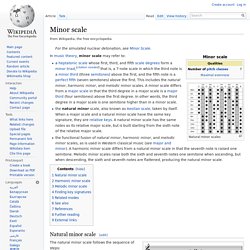
This includes the natural minor, harmonic minor, and melodic minor scales. Major and minor. Major and minor are frequently referred to in the titles of classical compositions, especially in reference to the key of a piece.
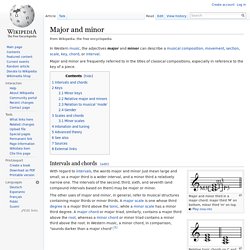
Intervals and chords[edit] Major and minor third in a major chord: major third 'M' on bottom, minor third 'm' on top. Play Relative tonic chords on C and A. Play Parallel tonic chords on C Major chord Minor chord The difference between the major and minor chord may be seen if they are drawn in chromatic circle. Tone deafness. Tone deafness is the lack of relative pitch, or the inability to distinguish between musical notes that is not due to the lack of musical training or education.

Tone deafness is the congenital form of amusia. It is also known as tune deafness, "tin ear", dysmelodia and dysmusia. Description[edit] The ability to hear and reproduce relative pitch, as with other musical abilities, is present in all societies and in most humans. Tone deafness appears to be genetically influenced although it can also be a result from brain damage.
Tone deafness is also associated with other musical-specific impairments such as the inability to keep time with music (the lack of rhythm), or the inability to remember or recognize a song. Neurology[edit] In nine of ten tone deaf people, the superior arcuate fasciculus in the right hemisphere could not be detected, suggesting a disconnection between the posterior superior temporal gyrus and the posterior inferior frontal gyrus. Oreille relative. Un article de Wikipédia, l'encyclopédie libre.

Contrairement à l'oreille absolue qui consiste en la mémorisation de la fréquence « en soi », l’oreille relative consiste en la mémorisation du rapport de fréquence. Oreille absolue. Un article de Wikipédia, l'encyclopédie libre.

Pour les articles homonymes, voir Absolu. Oreille harmonique. Un article de Wikipédia, l'encyclopédie libre.

Amusia. Basics of music processing[edit] Neurologically intact individuals appear to be born musical.
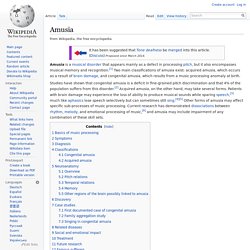
Even before they are able to talk, infants show remarkable musical abilities that are similar to those of adults in that they are sensitive to musical scales and a regular tempo.[2] Also, infants are able to differentiate between consonant and dissonant intervals. These perceptual skills indicate that music-specific predispositions exist.[2] Music-specific neural networks exist in the brain for a variety of music-related tasks.
Symptoms[edit] Symptoms of amusia are generally categorized as receptive, clinical, or mixed. Research suggests that patients with amusia also have difficulty when it comes to spatial processing.[10] Amusics performed more quickly than normal individuals on a combined task of both spatial and musical processing tasks, which is most likely due to their deficit. Music-specific disorders. Neuroscientists have learned a lot about the role of the brain in numerous cognitive mechanisms by understanding corresponding disorders.

Similarly, neuroscientists have come to learn a lot about music cognition by studying music-specific disorders. Even though music is most often viewed from a "historical perspective rather than a biological one"[1] music has significantly gained the attention of neuroscientists all around the world. For many centuries music has been strongly associated with art and culture. The reason for this increased interest in music is because it "provides a tool to study numerous aspects of neuroscience, from motor skill learning to emotion".[1] Musical hallucinations. Musical hallucinations fall under the category of auditory hallucinations and describe a disorder in which a sound is perceived as instrumental music, sounds, or songs.
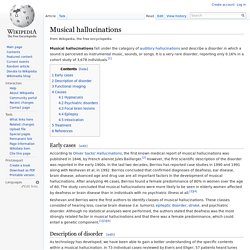
It is a very rare disorder, reporting only 0.16% in a cohort study of 3,678 individuals.[1] Early cases[edit] Keshevan and Berrios were the first authors to identify classes of musical hallucinations. These classes consisted of hearing loss, coarse brain disease (i.e. tumors), epileptic disorder, stroke, and psychiatric disorder. Although no statistical analyses were performed, the authors stated that deafness was the most strongly related factor in musical hallucinations and that there was a female predominance, which could entail a genetic component.[1][3][4] Description of disorder[edit] As technology has developed, we have been able to gain a better understanding of the specific contents within a musical hallucination. Amusie. Un article de Wikipédia, l'encyclopédie libre.
Sur les autres projets Wikimedia : amusie, sur le Wiktionnaire.